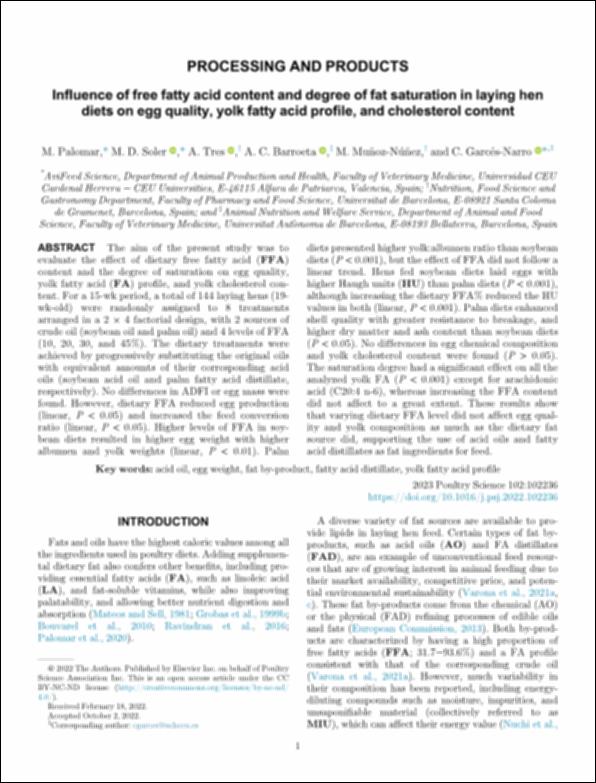Por favor, use este identificador para citar o enlazar este ítem:
http://hdl.handle.net/10637/14166Influence of free fatty acid content and degree of fat saturation in laying hen diets on egg quality, yolk fatty acid profile, and cholesterol content
| Título : | Influence of free fatty acid content and degree of fat saturation in laying hen diets on egg quality, yolk fatty acid profile, and cholesterol content |
| Autor : | Palomar Lloris, María Soler Sanchis, María Dolores Tres, A. Barroeta Lajusticia, Ana Cristina Muñoz Núñez, María Garcés Narro, Carlos |
| Materias: | Alimentos para animales.; Gallinas ponedoras - Alimentación.; Feeds - Composition.; Ácidos grasos.; Eggs - Quality control.; Huevos - Control de calidad.; Piensos compuestos.; Hens - Feeding and feeds.; Animal feeds.; Fatty acids. |
| Editorial : | Elsevier |
| Citación : | Palomar, M., Soler, M.D., Tres, A., Barroeta, A.C., Muñoz-Núñez, M. & Garcés-Narro, C. (2023). Influence of free fatty acid content and degree of fat saturation in laying hen diets on egg quality, yolk fatty acid profile, and cholesterol content. Poultry Science, vol. 102, i. 1 (jan.), art. 102236. DOI: https://doi.org/10.1016/j.psj.2022.102236 |
| Resumen : | The aim of the present study was to evaluate the effect of dietary free fatty acid (FFA) content and the degree of saturation on egg quality, yolk fatty acid (FA) profile, and yolk cholesterol content. For a 15-wk period, a total of 144 laying hens (19- wk-old) were randomly assigned to 8 treatments arranged in a 2 £ 4 factorial design, with 2 sources of crude oil (soybean oil and palm oil) and 4 levels of FFA (10, 20, 30, and 45%). The dietary treatments were achieved by progressively substituting the original oils with equivalent amounts of their corresponding acid oils (soybean acid oil and palm fatty acid distillate, respectively). No differences in ADFI or egg mass were found. However, dietary FFA reduced egg production (linear, P < 0.05) and increased the feed conversion ratio (linear, P < 0.05). Higher levels of FFA in soybean diets resulted in higher egg weight with higher albumen and yolk weights (linear, P < 0.01). Palm diets presented higher yolk:albumen ratio than soybean diets (P < 0.001), but the effect of FFA did not follow a linear trend. Hens fed soybean diets laid eggs with higher Haugh units (HU) than palm diets (P < 0.001), although increasing the dietary FFA% reduced the HU values in both (linear, P < 0.001). Palm diets enhanced shell quality with greater resistance to breakage, and higher dry matter and ash content than soybean diets (P < 0.05). No differences in egg chemical composition and yolk cholesterol content were found (P > 0.05). The saturation degree had a significant effect on all the analyzed yolk FA (P < 0.001) except for arachidonic acid (C20:4 n-6), whereas increasing the FFA content did not affect to a great extent. These results show that varying dietary FFA level did not affect egg quality and yolk composition as much as the dietary fat source did, supporting the use of acid oils and fatty acid distillates as fat ingredients for feed. |
| Descripción : | Este artículo se encuentra disponible en la página web de la revista en la siguiente URL: https://www.sciencedirect.com/science/article/pii/S0032579122005326 |
| URI : | http://hdl.handle.net/10637/14166 |
| Derechos: | http://creativecommons.org/licenses/by-nc-nd/4.0/deed.es |
| ISSN : | 0032-5791 1525-3171 (Electrónico) |
| Fecha de publicación : | 24-ene-2023 |
| Centro : | Universidad Cardenal Herrera-CEU |
| Aparece en las colecciones: | Dpto. Producción y Sanidad Animal, Salud Pública Veterinaria y Ciencia y Tecnología de los Alimentos |
Los ítems de DSpace están protegidos por copyright, con todos los derechos reservados, a menos que se indique lo contrario.


